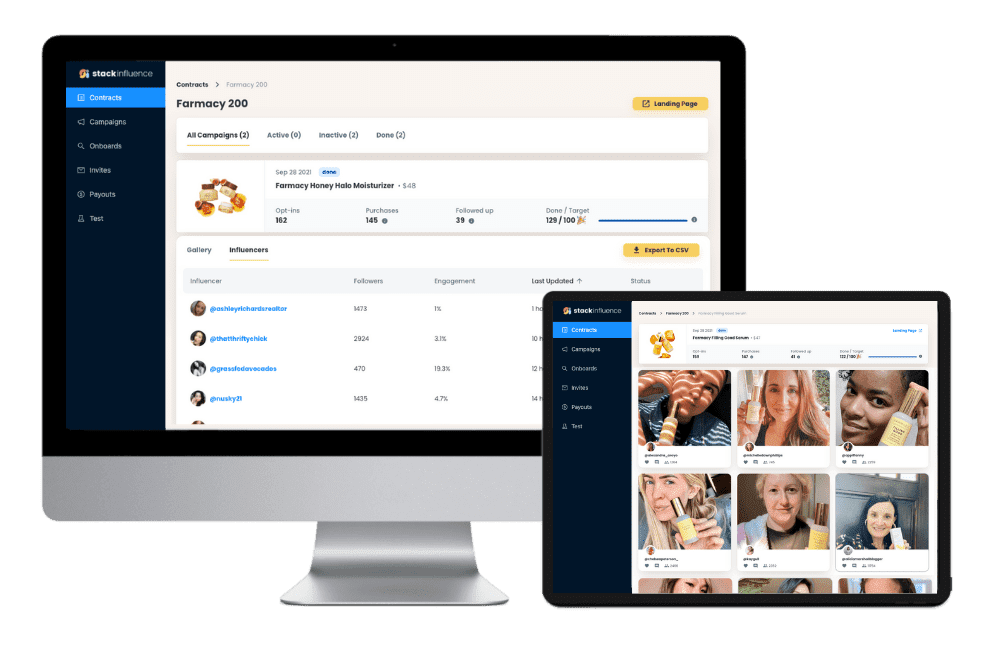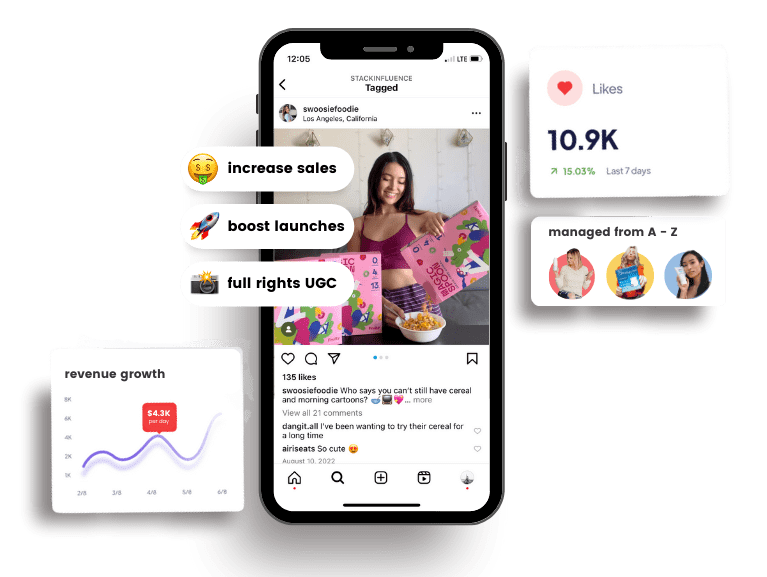Best Beauty Influencer Campaign Examples (2025)
14th
October, 2025
Influencer Marketing
Amazon Marketplace
Artificial Intelligence
TikTok Tips
In the world of beauty marketing, influencer campaigns on Instagram and TikTok continue to dominate in 2025. Top cosmetics and skincare brands are partnering with content creators – from mega-celebrities to micro-influencers – to drive product buzz, user-generated content (UGC), and e-commerce sales. It’s no wonder beauty and personal care brands now see an average 3.6x return on investment (ROI) for every $1 spent on influencer marketing, and 78% of beauty marketers consider engagement rate the most important success metric for these campaigns. Below, we highlight some of the best beauty influencer campaign examples (focused on the U.S. market) on Instagram and TikTok, complete with their strategies and key metrics. These examples show how leveraging influencers – especially micro-influencers and everyday content creators – can spark massive engagement and ROI for brands big and small.
1. Rhode Beauty – Hailey Bieber’s “Peptide Lip” Viral Challenge
When Hailey Bieber launched Rhode Beauty’s Peptide Lip Treatment, she didn’t rely on traditional ads – she started a viral social media challenge. Hailey and fellow creator Tate McRae flooded Instagram Reels and TikTok with “Get Ready With Me” tutorials showcasing the product’s versatility. The campaign cleverly leveraged TikTok’s challenge culture with hashtags like #RhodeLips and #PeptideLipShape, which united beauty lovers and prompted a wave of UGC as fans tried to recreate Hailey’s looks. The result was instant viral gold – the lip product became more than just a cosmetic, morphing into a community “movement” fueled by fans’ posts.
-
Platforms
Instagram & TikTok (viral challenge with branded hashtags)
-
Strategy
Celebrity founder + trending TikTok challenge + user-generated content
-
Metrics
The campaign reached millions of views across platforms, solidifying its place in social media history. The flood of fan-made videos created enormous buzz, repeatedly landing Rhode Beauty’s lip treatment on TikTok’s trending page. (Exact engagement figures weren’t disclosed, but the ubiquity of the hashtag and viral sounds indicated massive reach.)
Why it worked
Rhode tapped into TikTok-native behavior (challenges and GRWM videos) and authentic demos rather than polished ads. Hailey Bieber’s star power combined with relatable content (lip routines anyone can try) sparked high engagement. By encouraging fans to participate and post their own content, Rhode turned customers into co-creators, generating tons of free exposure through peer recommendations.

Unlock the Power of Micro Influencers and Elevate your Brand Today!

2. Dove – The Real Cost of Beauty Social Movement
-
Platforms
Instagram & TikTok (influencer videos, short film, hashtag challenge)
-
Strategy
Cause-driven content + celebrity advocates + micro-influencer amplification
-
Metrics
The campaign achieved monumental reach – over 19 million video views and a staggering 5 billion earned media impressions. It sparked widespread conversations around online safety and even inspired advocacy for legislation (such as the Kids Online Safety Act), showing how deeply it struck a chord.
Why it worked
Dove’s campaign succeeded by aligning with values and encouraging conversation rather than pushing a product. By using influencers (big and small) who genuinely cared about the issue, Dove built trust and credibility. This authenticity drove massive engagement (shares, comments, press coverage) – proving that when a beauty brand starts a meaningful movement, the campaign can transcend marketing and become a cultural moment.
3. Glossier – “Skin First, Makeup Second” Authenticity Campaign
-
Platforms
TikTok (primary) and Instagram (community posts)
-
Strategy
Mixed-tier influencers + community hashtag for user content + emphasis on bare-faced authenticity
-
Metrics
The hashtag went viral – the campaign amassed over 400 million views on TikTok. This incredible view count indicated not only huge reach, but that the message resonated with the social community. Glossier successfully sparked a cultural conversation about skincare vs. makeup, reinforcing its brand identity while racking up engagement.
Why it worked
Glossier hit a sweet spot by celebrating real skin at a time when consumers crave authenticity. The mix of big influencers and micro-influencers created broad reach with a personal touch. Everyday users felt inspired to join in with their own #SkinFirstMakeupSecond posts, generating organic buzz. In short, Glossier proved that honest, user-driven content (UGC) can be a powerful marketing engine – the campaign wasn’t just promoting products, but a lifestyle that followers eagerly bought into (both figuratively and literally).
4. Fenty Beauty – #FentyFace Inclusive Makeup Challenge
No list of beauty campaigns would be complete without Rihanna’s Fenty Beauty, which has redefined industry inclusivity. Fenty’s #FentyFace Challenge invited everyone to show off their unique makeup looks, emphasizing that beauty is for all. The brand assembled a diverse army of influencers – from YouTube icons like Jackie Aina and NikkieTutorials to rising micro-influencers across different countries. These creators demonstrated Fenty’s extensive shade range and encouraged fans to participate by posting their own #FentyFace. The campaign effectively turned a hashtag into a global celebration of diversity. By encouraging fans to “put your own face forward,” Fenty generated an explosion of UGC – makeup lovers worldwide shared tutorials, transformations, and personal stories using Fenty products.
-
Platforms
TikTok & Instagram (viral hashtag challenge, influencer tutorials)
-
Strategy
Inclusive influencer lineup (macro + micro) + global hashtag for user participation + empowerment message
-
Metrics
The viral success was massive. Fenty saw a flood of user-generated content, with millions of fan posts flooding Instagram and TikTok. In other words, everyone wanted to be a part of #FentyFace. This user-driven content created an ever-expanding ripple effect – every new post by a fan introduced the challenge (and Fenty products) to that person’s followers, yielding exponential organic reach. The campaign didn’t just sell foundation or lipstick; it built a community.
Why it worked
Fenty’s challenge embodied empowerment and inclusion, core values that resonated deeply with audiences who felt overlooked by traditional beauty campaigns. By showcasing real people of all skin tones (via both influencers and everyday users), the campaign felt welcoming and credible. The use of a fun, highly shareable challenge format on TikTok/Instagram lowered the barrier for participation – fans wanted to join in. This strategy turned customers into brand ambassadors en masse. The takeaway: Inclusivity + interactivity = engagement. Fenty created a movement, not just a message, and the beauty community responded with an outpouring of content and goodwill.
5. Estée Lauder – #MyShadeMyStory Diversity Campaign
Following Fenty’s lead on inclusion, Estée Lauder launched its own viral initiative called #MyShadeMyStory. This campaign invited people to share the personal stories behind their perfect foundation shade – effectively blending product promotion with personal empowerment. Estée Lauder teamed up with influencers from various backgrounds (e.g., former Miss World Manushi Chhillar, beauty bloggers like Shraddha Gurung, and male makeup artist Shantanu Dhope) to highlight diverse experiences in finding beauty products. Popular makeup TikToker Mikayla Nogueira also joined as a creator partner, posting enthusiastic reviews of Estée Lauder’s new 24-hour wear foundation and tagging #MyShadeMyStory. The campaign’s narrative approach – having influencers and consumers tell stories of embracing their unique skin tone – struck an emotional chord, much like Dove’s approach, but with a direct tie-in to Estée’s shade-inclusive product line.
-
Platforms
TikTok & Instagram (influencer videos, user story posts)
-
Strategy
Personal storytelling + diverse influencer cast + branded hashtag encouraging consumer stories
-
Metrics
The hashtag quickly became a global sensation. On TikTok alone, #MyShadeMyStory garnered over 100 million views, as users worldwide tuned in and contributed. The campaign not only drove those views but also created high engagement through comments and duets – people were discussing and amplifying each other’s shade stories. Despite some controversy (e.g., pushing gender norms boundaries or calls for even broader representation), the overwhelming response proved the campaign’s success in making people feel “seen”.
Why it worked
Estée Lauder tapped into a powerful insight: makeup is personal. By focusing on stories rather than just swatches, they made a product launch deeply meaningful. The use of well-loved influencers (like Mikayla) provided authenticity and excitement, while the inclusive message built trust in Estée’s commitment to diversity. The campaign shows how a legacy beauty brand can rejuvenate its image by leveraging influencer-led storytelling and UGC. When customers connect with your message, they essentially do the marketing for you by sharing their own content – and that peer-to-peer influence is priceless.
6. COSMEDIX
Not every successful campaign is driven by celebrity names – skincare brand COSMEDIX proved the power of micro-influencers and brand advocates. The COSMEDIX Crowd program set out to create an online community around the brand’s products, making it a prime example for Amazon sellers and indie e-commerce brands to emulate. Instead of one-off posts, COSMEDIX recruited a variety of smaller influencers, loyal customers, and skincare enthusiasts to test products and share honest reviews. These creators received product education and were encouraged to produce review content (tutorials, before-and-afters, testimonials), which COSMEDIX then featured on its own website and social channels as authentic social proof. In essence, COSMEDIX turned UGC and influencer content into a seamless part of its e-commerce experience – bridging social media and the point of sale.
-
Platforms
Instagram, TikTok, and brand’s own website (for reposting reviews)
-
Strategy
Micro-influencer outreach + product seeding (gifting products) + re-purposing UGC as shoppable content
-
Metrics
The results were impressive, especially for a micro-focused campaign. COSMEDIX’s influencer community program yielded a 527% ROI (return on investment) from the resulting sales and activation purchases, along with 3 million impressions and 34,000 engagements on the content generated. Those numbers far exceeded expectations for a niche brand and even earned COSMEDIX a Shorty Award for “Best in Beauty”. The high engagement rate and ROI demonstrated how effective micro-influencer campaigns can be when done right.
Why it worked
COSMEDIX succeeded by scaling up word-of-mouth in a structured way. Micro-influencers bring smaller but highly engaged audiences; their followers trust their skincare recommendations as if hearing from a friend. By compensating these influencers with product (not hefty fees) and focusing on genuine reviews, the brand ensured the content felt real. This authenticity built deep trust with consumers – as evidenced by the strong sales conversion (500%+ ROI). For e-commerce and Amazon marketplace sellers, this approach is a blueprint: engage a network of niche creators who love your product, and let their content do the selling. It’s cost-effective and creates evergreen marketing assets (reviews, testimonials) you can reuse across your channels.

Unlock the Power of Micro Influencers and Elevate your Brand Today!

Conclusion to Best Beauty Influencer Campaign Examples
Finally, remember that even if you’re not a huge brand, you can apply these principles. Micro-influencer campaigns are particularly accessible to smaller e-commerce businesses and Amazon sellers. With creative strategy, a modest budget can go a long way. Platforms like Stack Influence help connect brands to everyday creators and even automate product seeding campaigns, making it easier to generate UGC and scale word-of-mouth marketing. By partnering with passionate micro-influencers, even an indie beauty product can explode in popularity through social media buzz. In 2025, the playing field is more level than ever – it’s all about finding the right influencers (big or small) who align with your brand and letting their creative voices shine.
In summary, the best beauty influencer campaigns of 2025 proved that authentic content + engaged communities = marketing success. Whether it’s a viral TikTok that sells out a lip gloss overnight or a long-term micro-influencer program that steadily builds brand love, influencer marketing offers a powerful path to reach today’s social-savvy consumers. By learning from these examples – focusing on authenticity, encouraging UGC, tracking engagement metrics, and embracing micro-influencers – brands can create their own winning campaigns that not only drive metrics up, but also build meaningful connections with their audience. And in the age of social media, those genuine connections are the true beauty of influencer marketing success.

By William Gasner
CMO at Stack Influence
William Gasner is the CMO of Stack Influence, he's a 6X founder, a 7-Figure eCommerce seller, and has been featured in leading publications like Forbes, Business Insider, and Wired for his thoughts on the influencer marketing and eCommerce industries.
Want new articles before they get published? Subscribe to our Awesome Newsletter.
stack up your influence
turning creativity into currency
our headquarters
111 NE 1st St, Miami, FL 33132
our contact info
[email protected]
stack up your influence
turning creativity into currency
our headquarters
111 NE 1st St, 8th Floor
Miami, FL 33132


